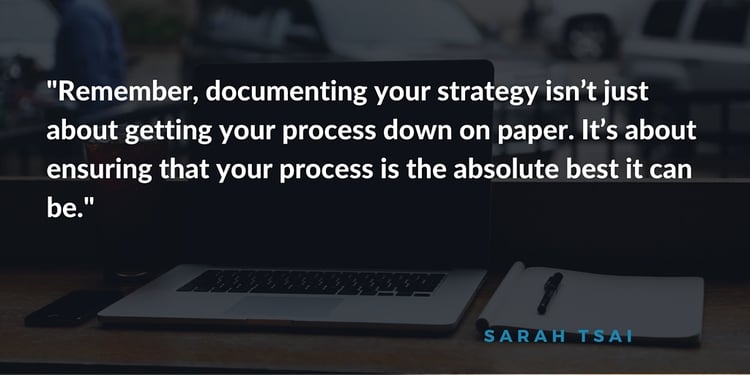- Jul 20, 2016
- By Sarah Tsai
- In Inbound Marketing
5 Reasons to Document an Inbound Marketing Campaign Strategy for a Better 2017

Although it takes hard work and some fantastic ideas to launch an effective inbound marketing campaign, there’s another factor that’s equally as important to your inbound success: documentation.
Documentation is so much more than semi-organized reminders of things you want or need to do. It lays out the purpose and intent of your inbound campaign, details who is responsible for what and outlines how the team collectively measures success.
Furthermore, here are five reasons why you shouldn’t skip this vital step and some of the key elements that should be recorded in the campaign overview and various strategy documents.
Brand Vision
Although your company presents one image to the public, the reality is that there are a lot of different moving parts behind the scenes. Ensuring that everyone involved, from interns up to the VP, incorporates your brand vision in their actions takes a great deal of work. And needless to say, the best way to keep everyone in line is to document every aspect of the public image of your company brand.
Consistency means a lot to customers, particularly those who have been your supporters for a while. If there’s something out of place, people will notice, and odds are good they won’t react positively. Just as people have come to be loyal to your company because of your products and services, your marketing also plays an important part. Using outdated logos and unfamiliar colors — or deviating from your company’s acceptable tone — are all ways to poorly communicate your message with your customers. It’s very easy to overlook vital elements of your message.
But consistency is also important for internal purposes. For example, your company might refer to potential customers as “leads,” but an individual team member might mistakenly use “prospects” instead. This is the exact type of disconnect that frequently gets lost in the shuffle, but can lead to confusion for your team and for the customer. Documentation allows your team to use a shared language which makes training and communications across departments easier.
That’s why it’s so important to document every part of your brand vision. People crave familiarity. Without it, your customers and your team may look elsewhere. Make sure you have all of your ducks in a row so your audience never has a reason to feel unwelcome.
Process Improvement
The process of documenting an entire strategy can be rather daunting. It’s also downright annoying for some, but for others it’s a welcome challenge.
Documenting any internal process requires you to examine every nook and cranny of your operation. That means that even the smallest actions have to be remembered, considered and discussed. And while it is can at times be tedious to go through the minutiae of process documentation, it’s the perfect opportunity for you to make sure your process is really operating at maximum efficiency.
Businesses around the world brainstorm for new ideas all the time, and with good reason. Looking at an idea with different lenses can open up a world of possibilities that seemingly didn’t exist moments ago. The same concept is true for reviewing your inbound marketing strategy as you document. Instead of doing something because that’s how you’ve always done it, you have the ability to question the things you do and ask if those actions are the best possible way to achieve your goals. You can have honest discussions with your employees and your superiors about what each person does to create a successful marketing machine.

Remember, documenting your strategy isn’t just about getting your process down on paper. It’s about ensuring that your process is the absolute best it can be. And it just so happens that the act of documenting your inbound marketing campaign gives you the ultimate brainstorming forum for improving your process.
Productivity
In order for any organization to be truly productive, every team member must do their job to the best of their abilities. But problems can arise when the responsibilities and end results of those jobs aren’t clearly laid out. This can lead to duplicate work, unassigned tasks and lack of recognition for a job well-done, which can subsequently result in decreased morale and employee turnover.
True productivity occurs when everyone knows what’s expected of them, and when those people are well-trained in their roles. Documenting your processes will help make sure that each person is where he or she needs to be within your organization. It’ll also help shed light on any inefficiencies that may pop up due to rushed or insufficient training.
Most importantly, documenting your inbound marketing campaign strategy will help in the inevitable instances where real life interferes with business. Your documentation will save you when someone comes down with the flu or goes out on maternity leave. Because you’ll know exactly who does what, you can quickly formulate a gameplan to tackle a crisis, cover absences or put out any fire on the spur of the moment.
Accountability
There’s one clear benefit to having all of your responsibilities and actions laid out on paper. For perhaps the first time, you can plainly see who’s in charge of which functions. And this allows you to see if you have important pieces of your process that fall into shady areas that aren’t covered by one individual or team.
Of course, a significant part of your process write-up is determining who’s responsible for what. This may be a work in progress at first, but the more you look at the productivity of your employees, the better you’ll get at understanding what your employees are capable of. In other words, you don’t want to give someone too much or too little to do. Once again, sitting down and discussing these issues during the documentation process will go a long way towards making sure everyone buys in from the start.
This focus on accountability goes deeper than sorting out job responsibilities for your team. It also strives to make sure there’s a clear delineation of the functions of each department. For instance, there has been a long-standing disconnect between sales and marketing, largely due to the fact that the sales team is often unconvinced that marketing’s leads are ready for the sales process. The act of documenting what constitutes a sales qualified lead and what comprises a marketing qualified lead will help both sides get a better handle on their responsibilities. As a result, each side will feel better about its own work, which will make the two groups more cohesive, resulting in increased morale and productivity.
Analysis
The accountability that results from a documented process is a double-edged sword in some ways. While it’s great to see who’s doing the best work, you may also find that some aren’t pulling their weight. However, this does give you a chance to assess whether a given person is in the right role.
Just as you underwent a detailed look at the actions that comprised your marketing strategy, you can also sit with an employee and try to determine the best fit for that individual. Maybe they were hired as a marketing analyst, but they’d actually best serve your company as a sales rep. This is something that’s a lot easier if you have a documented process that details exactly what’s required of your analysts and your sales representatives. Matching a person to their niche is actually quite simple if you know what’s required of each position within your company. This inside look of the job requirements and team skills can do a lot to help you prepare for the future.
Document for Success

Successful inbound marketing campaigns don’t just happen. They’re the by-product of planning, analysis and constant performance improvement. Documentation is an essential part of any inbound marketing campaign strategy, and without this documentation, even the best-laid plans are sure to fail. The absence of a well-documented plan means that it’s even harder for you to adjust your strategies when interim goals are not met and come up with a plan for how to move forward based on the the concrete plan of where you’ve been and where you’re going.
In order to move your inbound marketing forward into 2017 and beyond, documenting your approach and your future plans is essential, and I don’t mean jotting notes on scraps of paper or Post-It notes lining your monitor (which we all do here at Cleriti!). The best way you can ensure that your next inbound marketing campaign strategy will be successful is to document everything about the process. Track everything, from the people executing the process to what they’ll do to what happens if part of the process fails. You’ll learn a lot about your company, your employees and the best way to achieve your goals.





